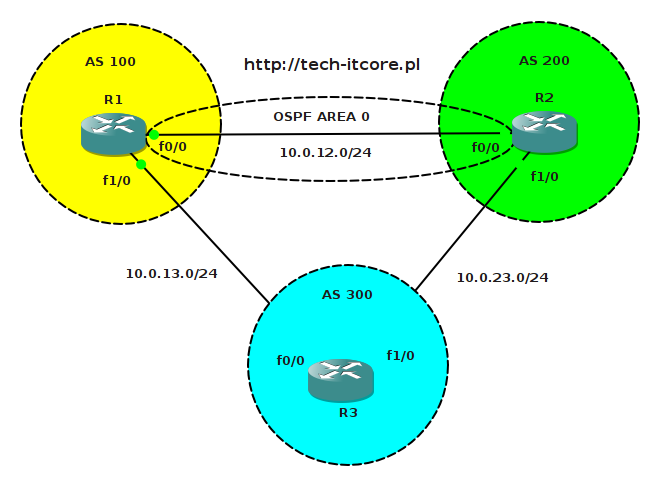Cele:
- Skonfiguruj OSPF pomiędzy R1 i R2. Rozgłoś ich interfejsy Loopback.
- Skonfiguruj EBGP pomiędzy R1 i R3 oraz R2 i R3. Rozgłoś interfejsy Loopback.
- R1 i R2: Trasa do sieci 1.1.1.0/24 i 2.2.2.0/24 prowadzi przez R3 pomimo tego, że routery mają ze sobą bezpośrednie połączenie. Dlaczego? Popraw konfigurację tak, aby R1 i R2 korzystały z łącza, którym są bezpośrednio podłączone.
Adresy IP routerów:
R1
| Interfejs | IP |
|---|---|
| FastEthernet 0/0 | 10.0.12.1/24 |
| FastEthernet 1/0 | 10.0.13.1/24 |
| Loopback 0 | 1.1.1.1/24 |
R2
| Interfejs | IP |
|---|---|
| FastEthernet 0/0 | 10.0.12.2/24 |
| FastEthernet 1/0 | 10.0.23.2/24 |
| Loopback 0 | 2.2.2.2/24 |
R3
| Interfejs | IP |
|---|---|
| FastEthernet 0/0 | 10.0.13.3/24 |
| FastEthernet 1/0 | 10.0.23.3/24 |
Schemat sieci:
Router: 3640
IOS: c3640-jk9o3s-mz.124-16a.bin
Rozwiązanie
Skonfiguruj OSPF pomiędzy R1 i R2. Rozgłoś ich interfejsy Loopback.
Na routerach R1 i R2 uruchamiamy proces OSPF i rozgłaszamy w nim sieci 1.1.1.0/24 oraz 2.2.2.0/24. Przy okazji zmienimy typ sieci dla interfejsów Loopback na point-to-point:
R1(config)#interface loopback 0 R1(config-if)#ip ospf network point-to-point R1(config-if)#exit R1(config)# R1(config)#router ospf 1 R1(config-router)#network 10.0.12.0 0.0.0.255 area 0 R1(config-router)#network 1.1.1.0 0.0.0.255 area 0
R2(config)#interface loopback 0 R2(config-if)#ip ospf network point-to-point R2(config-if)#exit R2(config)# R2(config)#router ospf 1 R2(config-router)#network 10.0.12.0 0.0.0.255 area 0 R2(config-router)#network 2.2.2.0 0.0.0.255 area 0
Po chwili każdy z nich ma nowy wpis w tablicy routingu:
R1#show ip route ospf
2.0.0.0/24 is subnetted, 1 subnets
O 2.2.2.0 [110/2] via 10.0.12.2, 00:00:00, FastEthernet0/0
Na koniec przetestujmy łączność:
R1#ping 2.2.2.2 source loopback 0 Type escape sequence to abort. Sending 5, 100-byte ICMP Echos to 2.2.2.2, timeout is 2 seconds: Packet sent with a source address of 1.1.1.1 !!!!! Success rate is 100 percent (5/5), round-trip min/avg/max = 4/16/24 ms
Skonfiguruj EBGP pomiędzy R1 i R3 oraz R2 i R3. Rozgłoś interfejsy Loopback.
Uruchamiamy proces BGP na wszystkich routerach i definiujemy sąsiadów. Uwaga – nie tworzymy sesji EBGP pomiędzy R1 i R2:
R1(config)#router bgp 100 R1(config-router)#neighbor 10.0.13.3 remote-as 300 R1(config-router)#network 1.1.1.0 mask 255.255.255.0
R2(config)#router bgp 200 R2(config-router)#neighbor 10.0.23.3 remote-as 300 R2(config-router)#network 2.2.2.0 mask 255.255.255.0
R3(config)#router bgp 300 R3(config-router)#neighbor 10.0.13.1 remote-as 100 R3(config-router)#neighbor 10.0.23.2 remote-as 200 R3(config-router)#neighbor 10.0.13.1 next-hop-self R3(config-router)#neighbor 10.0.23.2 next-hop-self
Na R1 i R2 rozgłaszamy interfejsy Loopback w BGP. Na R3 użyliśmy opcji next-hop-self dzięki czemu routery będą miały łączność z sieciami 1.1.1.0/24 oraz 2.2.2.0/24 w BGP. Sprawdźmy status na R2:
R2#show ip bgp
BGP table version is 3, local router ID is 2.2.2.2
Status codes: s suppressed, d damped, h history, * valid, > best, i - internal,
r RIB-failure, S Stale
Origin codes: i - IGP, e - EGP, ? - incomplete
Network Next Hop Metric LocPrf Weight Path
*> 1.1.1.0/24 10.0.23.3 0 300 100 i
*> 2.2.2.0/24 0.0.0.0 0 32768 i
Mamy sieć 1.1.1.0/24 do której trasa prowadzi przez 10.0.23.3 (R3).
R1 i R2: trasa do sieci 1.1.1.0/24 oraz 2.2.2.0/24 prowadzi przez R3 pomimo tego, że routery mają ze sobą bezpośrednie połączenie. Dlaczego? Popraw konfigurację tak, aby R1 i R2 korzystały z łącza, którym są bezpośrednio podłączone.
No właśnie po uruchomieniu BGP pingując adres 2.2.2.2 z R1 pakiety kierowane są do routera R3 zamiast bezpośrednio do R2.
R1#traceroute 2.2.2.2 source loopback 0 Type escape sequence to abort. Tracing the route to 2.2.2.2 1 10.0.13.3 12 msec 16 msec 24 msec 2 10.0.23.2 36 msec * 36 msec
Trasa routingu na R1:
R1#show ip route bgp
2.0.0.0/24 is subnetted, 1 subnets
B 2.2.2.0 [20/0] via 10.0.13.3, 00:43:34
Dlaczego tak jest? W tm przypadku „winny” jest dystans administracyjny (AD). Wartość AD dla tras rozgłaszanych przez EBGP to 20, natomiast dla OSPF 110. Poniżej domyślne wartości AD dla różnych protokołów routingu:
| Protokół | Dystans administracyjny |
|---|---|
| EBGP | 20 |
| EIGRP | 90 |
| IGRP | 100 |
| OSPF | 110 |
| IS-IS | 115 |
| RIP | 120 |
| IBGP | 200 |
R1 otrzymuje informacja dotyczące sieci 2.2.2.0/24 z dwóch protokołów routingu (EBGP oraz OSPF), a ponieważ niższa wartość ma większy priorytet, wybiera on trasę przez R3. Problem możemy rozwiązać korzystając z BGP backdoor.
R1(config)#router bgp 100 R1(config-router)#network 2.2.2.0 mask 255.255.255.0 backdoor
W ten sposób trasy rozgłaszane przez IGP (OSPF w naszym przypadku) mają większy priorytet niż te z EBGP. Sprawdźmy tablicę routingu:
R1#show ip route | begin Gateway
Gateway of last resort is not set
1.0.0.0/24 is subnetted, 1 subnets
C 1.1.1.0 is directly connected, Loopback0
2.0.0.0/24 is subnetted, 1 subnets
O 2.2.2.0 [110/2] via 10.0.12.2, 00:04:46, FastEthernet0/0
10.0.0.0/24 is subnetted, 2 subnets
C 10.0.12.0 is directly connected, FastEthernet0/0
C 10.0.13.0 is directly connected, FastEthernet1/0
Świetnie trasa do 2.2.2.0/24 wskazuje bezpośrednio na R2. Poprawimy teraz konfigurację na drugim routerzze:
R2(config)#router bgp 200 R2(config-router)#network 1.1.1.0 mask 255.255.255.0 backdoor
R2#show ip route | begin Gateway
Gateway of last resort is not set
1.0.0.0/24 is subnetted, 1 subnets
O 1.1.1.0 [110/2] via 10.0.12.1, 00:00:20, FastEthernet0/0
2.0.0.0/24 is subnetted, 1 subnets
C 2.2.2.0 is directly connected, Loopback0
10.0.0.0/24 is subnetted, 2 subnets
C 10.0.12.0 is directly connected, FastEthernet0/0
C 10.0.23.0 is directly connected, FastEthernet1/0
A co się stanie jeśli wyłączymy link pomiędzy R1 a R2?
R1(config)#interface fastEthernet 0/0 R1(config-if)#shutdown R1(config-if)# *Mar 1 02:28:32.775: %OSPF-5-ADJCHG: Process 1, Nbr 2.2.2.2 on FastEthernet0/0 from FULL to DOWN, Neighbor Down: Interface down or detached
Gateway of last resort is not set
1.0.0.0/24 is subnetted, 1 subnets
C 1.1.1.0 is directly connected, Loopback0
2.0.0.0/24 is subnetted, 1 subnets
B 2.2.2.0 [200/0] via 10.0.13.3, 00:00:33
10.0.0.0/24 is subnetted, 1 subnets
C 10.0.13.0 is directly connected, FastEthernet1/0
Tracimy relację sąsiedztwa w OSPF, ale w tablicy routingu znów pojawia się wpis BGP, a my mamy łączność ponownie przez R3:
R1#traceroute 2.2.2.2 source loopback 0 Type escape sequence to abort. Tracing the route to 2.2.2.2 1 10.0.13.3 16 msec 20 msec 20 msec 2 10.0.23.2 28 msec * 36 msec
To tyle na dziś, czekamy na Wasze uwagi i komentarze.


0 Komentarze.